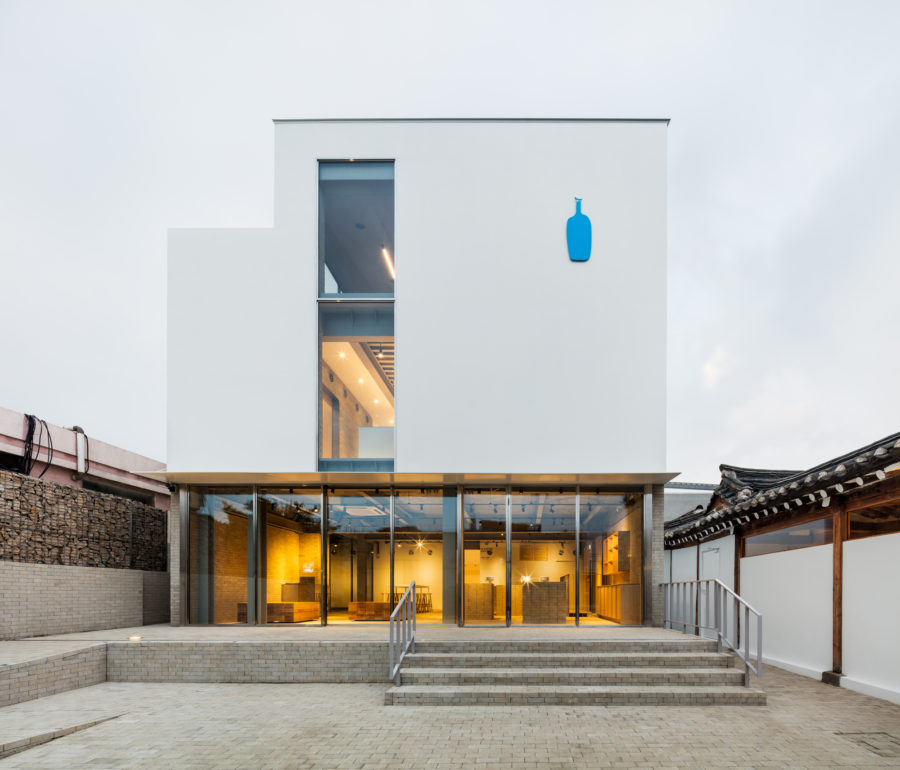国立競技場にほど近い千駄ヶ谷の商住混在したエリアに位置する、1・2階のテナント空間上部に施主自邸が配された事務所併用住宅である。狭い前面道路による160%の容積率に対して最大限の空間を確保しながら、十分な収益性のあるテナント空間と快適な住空間が共存する建築を模索した。それまでゆとりある庭付き一戸建て住宅で暮らしていた5人家族の施主は、都心部で床面積も減少する新しい生活空間への懸念があったが、それを覆すようなおおらかで開放的な空間を目指した。
通りレベルでは住環境として高密な場所ながら、容積率は低くとも日影規制内で高さ20mまで建築可能なことを利用し、規制を避けて低く抑えた周辺建物の上空を空地と見立てて住空間に活かすことを考えた。日影規制を徹底的に検討した結果、北側を最大限に高くした階段状のボリュームにたどり着いた。低層部の階高を高くしてテナント空間としての価値を高めると同時に、メゾネットとした住宅部分を周辺建物より高くもち上げることで、全方位に開放感のある住空間と各階の広々とした屋上テラスが生まれている。
使い方や日影規制に応じて変形させた異形平面が積層され、そのズレから生まれるさまざまな屋外空間が内部を外部に拡張する通路やテラスとして各階に取り込まれる。隣地境界沿いの2面を耐力壁として閉じて垂れ壁のような深いRC梁を交錯させることで、複雑な形状にも関わらずテラス沿いの躯体は細い丸柱のみに抑えられている。網なし耐熱結晶化ガラスによる大型木製防火サッシの利用と相まって、耐火建築らしからぬ開放感あるファサードが実現され、内外が一体となって明るく広がりのある空間が生まれた。植栽が散りばめられたテラスが連なる建物の隙間空間は、谷底から空へと続く渓谷のような立体庭となって、屋上へと開けていく。
深い梁せいを利用して各階の床下には半階分ほどの厚みのインフラ層が設けられ、天井懐・設備スペース・ロフト・小屋裏収納・床下収納・植栽ピットなどとして上下階から有効活用されることで、床面積以上のキャパシティと自由で開かれた主空間が生まれた。この分厚くはねだした層の周囲は屋上手摺の日影規制免除に必要な縦格子意匠を展開した帯状ファサードで覆われ、ルーバー効果で周囲からの視線をコントロールすると同時に水平ボリュームの積層を強調している。
最上階の4階を玄関とするメゾネットの住宅部分では、上階のLDK空間を高窓へ伸び上がるワンルームとし、下階には本棚に囲まれた広間を廊下代わりに4つの個室と水回りがコンパクトに配された。各階の主空間である4階リビングダイニングと3階広間は、書斎も兼ねた階段室を介して帯状のワンルームとしてゆるやかにつながり、さらに各階の全開放可能な大型サッシから屋外テラスへと拡張し、それが鮮やかな緑に囲まれた外階段で再び結ばれて、内外一体となった大きな立体ループが形成される。リビングの高窓の先には渦巻き状に巻き上がるもう1つの屋上テラスが広がり、空に浮かぶ大きな滑り台のようなプレイグラウンドが頂部を彩る。2層の住宅と3層のテラスを巡るこの回遊性に満ちた空間連続体では、周縁に配された家具や植栽によってさまざまな場所が生まれ、その中を光・風・視線が流れて子供たちが駆け回る。
厳しい諸条件の中、制限の中からあぶり出された敷地のポテンシャルが緻密に統合されて、このプロジェクトならではの存在感ある意匠に昇華されたのではないかと思う。背伸びした要塞のような佇まいの裏に隠れた、緑あふれる小高いオアシス。都心居住や複合用途建築の1つの在り方を提案すると同時に、1人の人間としてここで育つ子供たちを心から羨ましく思えるような、楽しく伸びやかな空間を目指した。東京の空を存分に味わう豊かな暮らしを期待している。(小室 舞)
Office combined housing in a dense area enjoying the sky by stacking irregularly shaped planes
Located in a mixed-use area in Sendagaya, near the National Stadium in Tokyo, the project is composed of two floors of tenant spaces and the client’s two-story residence above them. The main challenge of the project is how to accommodate comfortable residential environments and sufficiently profitable tenant spaces within the site constraints, which allowed only 160% of the maximum floor area ratio due to the narrow front street. The client, a family of five who used to live in an ample detached house with a garden, had concerns about the spatial quality of their new house with a less available floor area in a denser neighborhood. Thus, we tried to make it as open and generous as possible by actively incorporating outdoor spaces, despite the difficult site constraints.
Despite the low floor area ratio allowance, the maximum building height of the site Is defined at 20m If the volume is adapted to the complicated shadow calculation. However, most of the buildings nearby are kept lower than 10m to avoid extra code compliance processes. While the neighborhood is relatively dense on the street level for residential use, we found potential open voids to create comfortable environments above the surrounding low buildings. Therefore, the building volume was developed to be taller on the northern side, elevating the duplex residence higher than neighboring roofs while maximizing the building volume and capturing open views over the surroundings.
Each level’s floor plate is uniquely skewed according to the shadow regulation, usages, spatial sequences, and vertical relationships. This stacking generates shading overhangs and various outdoor spaces such as external hallways and green terraces without interrupting GFA limitations. Besides the closed building facade along the site boundary accommodating main loadbearing walls, the articulated deep concrete beams allow the façade structure along the terraces to be open and transparent, encouraging inside and outside to merge. Large timber window walls recently certificated for fire resistance deliver open and bright interior spaces, unlike typical fireproof buildings required in most dense urban areas, including this site. The void space around the building with distributed lush vegetations at each terrace forms a cascade of sequential vertical gardens like a canyon stretching from the bottom courtyard towards the sky.
The resulting structural depth, about half a story deep, functions as servant layers between each floor, providing infrastructural supports to the floor below and above, such as mechanical space, attic storage, loft, underfloor storage, planting pit, etc., which allows the main spaces to be more open and flexible. The linear façades around the building’s slab volumes are wrapped by metal bands with repetitive vertical slats like louvers. Their design comes from the positive interpretation of the code requirements forcing a vertical slats design on the rooftop balustrade to conform to the shadow regulation. The continuous vertical louvers allow for interplay between openness to the perpendicular views and privacy from the diagonal views, besides enhancing of horizontality of the floor layers.
On the top floor of the building, the entrance level of the duplex residence accommodates the tall and generous single room with clerestory windows for the living room and kitchen. On the floor below, the triangular hall surrounded by the bookshelves anchor four bedrooms and bathrooms. Through the fully openable sliding windows on each floor, both the living room and the hall can extend towards the planted terraces and become a part of the living spaces. While the generous stairway with the study corner connects the living room and the hall openly to create a continuous spatial strip, two terraces are also connected through the outdoor stairway surrounded by abundant vegetation. Beyond the clerestory window of the living room, a roof terrace spirals up to the wide slope covered by the artificial turf, resembling an exclusive playground almost floating over the sky. Openly connected generous spaces create a spatial continuum of inside and outside throughout the duplex and three levels of the terraces, which forms a sort of a ‘three-dimensional loop’ of the living spaces. Various casework and vegetation are distributed along the periphery of this living space loop, creating different characters of the places. Besides joyful kids running around, light, air, view, and all the flow of life and nature circulate seamlessly inside and outside.
Through an elaborate analysis and studies of the site’s conditions and the limitations to make use of Its full potential, a distinctive building resembling a fortress stands out from the urban fabric thanks to Its irregular terraces and lush vegetation. This project is intended to suggest one way of the approach toward mixed-use development and living spaces in the urban context. At the same time, we purely pursued the sort of abundant and enjoyable living spaces where we would almost feel envy the kids growing up there. We hope for the client to enjoy their new life surrounded by the Tokyo skyline. (Mai Komuro)
【IBIS SENDAGAYA】
所在地:東京都渋谷区千駄ヶ谷1丁目
用途:複合施設、戸建住宅
クライアント:個人
竣工:2021年
設計:KOMPAS
担当:小室 舞、酒井英規
構造設計:平岩構造計画
設備:ZO設計室
植栽:塚田有一(温室)
施工:大原工務所
撮影:Vincent Hecht
工事種別:新築
構造:RC造
規模:地上4階
敷地面積:268.66m²
建築面積:163.87m²
延床面積:428.37m²
設計期間:2018.12-2019.11
施工期間:2019.12-2021.04
【IBIS SENDAGAYA】
Location: 1, Sendagaya, Shibuya-ku, Tokyo, Japan
Principal use: Complex facilities, Residential
Client: Individual
Completion: 2021
Architects: KOMPAS
Design team: Mai Komuro, Hidenori Sakai
Structure engineer: HSC
Facility: Zo
Planting: Yuichi Tsukada / Onshitsu
Contractor: O’hara Architectural and Construction
Photographs: Vincent Hecht
Construction type: New Building
Main structure: Reinforced Concrete construction
Building scale: 4 stories
Site area: 268.66m²
Building area: 163.87m²
Total floor area: 428.37m²
Design term: 2018.12-2019.11
Construction term: 2019.12-2021.04








